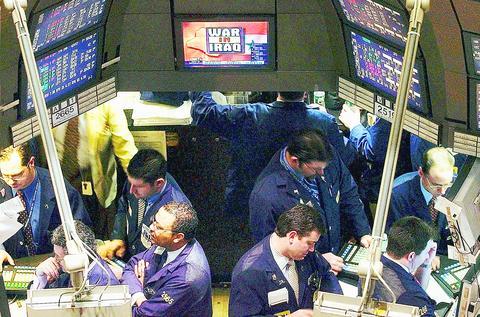Is the bell tolling for the New York Stock Exchange's daily market-opening ritual? On three mornings this week, the exchange refrained from its daily ceremony in which invited guests, who have included Arnold Schwarzenegger and Nelson Mandela, ring the opening bell for television viewers around the world.
The longest bear market since the Great Depression, and the Iraq war may have dampened enthusiasm for the eight-year-old practice.

PHOTO: AP
"People are not in a celebratory mood," said Clive Chajet, chairman of Chajet Consultancy, who recently rang the opening bell at the neighboring American Stock Exchange after advising that exchange on marketing.
Ringing the opening bell Monday: Susan Byrne, chief executive of Westwood Holdings Group Inc, a Dallas-based institutional money manager celebrating its 20th anniversary. NYSE clerk Martin Torelli rang the bell today. His brother, Lieutenant Colonel Christopher Torelli, is with a US Army counter-terrorism unit overseas.
Robert Zito, the exchange's executive vice president for communications, didn't immediately return calls for comment.
When the exchange skips the opening bell ceremony, a sole floor official pushes a button that clangs a 10-second bell in each of the exchange's five trading rooms. It kicks off US trading in stocks at 9:30am.
Commercializing the opening bell dates to 1995, when exchange Chairman Richard Grasso, elevated to the top job after working his way up the exchange ranks, began promoting the NYSE as a "brand." Zito approached General Electric Co's CNBC financial news network, which was broadcasting from the American Stock Exchange, and suggested the company do live reports from the NYSE floor. The bell ceremony is now broadcast on some two-dozen networks around the world and reaches some 110 million viewers a day.
Exchange staffers cautioned not to read too much into the ringing rout. Chief executives of the exchange's 2,800 listed companies often ask to ring the bell to mark anniversaries or promotions, and the lull may be a fluke of scheduling.
Yet the ringing is also a perk of companies going public, and just three this year debuted on the Big Board: Provident Financial Services, Endurance Specialty Holdings Ltd, and Telkom SA Ltd.
The benchmark Standard & Poor's 500 Index has lost 43 percent from its peak in March 2000.
"The IPO business," said Grasso at a briefing yesterday, "is virtually non-existent."

Intel Corp chief executive officer Lip-Bu Tan (陳立武) is expected to meet with Taiwanese suppliers next month in conjunction with the opening of the Computex Taipei trade show, supply chain sources said on Monday. The visit, the first for Tan to Taiwan since assuming his new post last month, would be aimed at enhancing Intel’s ties with suppliers in Taiwan as he attempts to help turn around the struggling US chipmaker, the sources said. Tan is to hold a banquet to celebrate Intel’s 40-year presence in Taiwan before Computex opens on May 20 and invite dozens of Taiwanese suppliers to exchange views

Application-specific integrated circuit designer Faraday Technology Corp (智原) yesterday said that although revenue this quarter would decline 30 percent from last quarter, it retained its full-year forecast of revenue growth of 100 percent. The company attributed the quarterly drop to a slowdown in customers’ production of chips using Faraday’s advanced packaging technology. The company is still confident about its revenue growth this year, given its strong “design-win” — or the projects it won to help customers design their chips, Faraday president Steve Wang (王國雍) told an online earnings conference. “The design-win this year is better than we expected. We believe we will win

Chizuko Kimura has become the first female sushi chef in the world to win a Michelin star, fulfilling a promise she made to her dying husband to continue his legacy. The 54-year-old Japanese chef regained the Michelin star her late husband, Shunei Kimura, won three years ago for their Sushi Shunei restaurant in Paris. For Shunei Kimura, the star was a dream come true. However, the joy was short-lived. He died from cancer just three months later in June 2022. He was 65. The following year, the restaurant in the heart of Montmartre lost its star rating. Chizuko Kimura insisted that the new star is still down

While China’s leaders use their economic and political might to fight US President Donald Trump’s trade war “to the end,” its army of social media soldiers are embarking on a more humorous campaign online. Trump’s tariff blitz has seen Washington and Beijing impose eye-watering duties on imports from the other, fanning a standoff between the economic superpowers that has sparked global recession fears and sent markets into a tailspin. Trump says his policy is a response to years of being “ripped off” by other countries and aims to bring manufacturing to the US, forcing companies to employ US workers. However, China’s online warriors